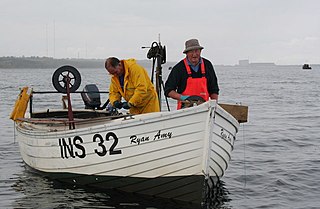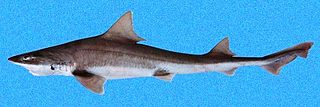
Trawling is an industrial method of fishing that involves pulling a fishing net through the water behind one or more boats. The net used for trawling is called a trawl. This principle requires netting bags which are towed through water to catch different species of fishes or sometimes targeted species. Trawls are often called towed gear or dragged gear.

Longline fishing, or longlining, is a commercial fishing angling technique that uses a long main line with baited hooks attached at intervals via short branch lines called snoods or gangions. A snood is attached to the main line using a clip or swivel, with the hook at the other end. Longlines are classified mainly by where they are placed in the water column. This can be at the surface or at the bottom. Lines can also be set by means of an anchor, or left to drift. Hundreds or even thousands of baited hooks can hang from a single line. This can lead to many deaths of different marine species. Longliners – fishing vessels rigged for longlining – commonly target swordfish, tuna, halibut, sablefish and many other species.

Bycatch, in the fishing industry, is a fish or other marine species that is caught unintentionally while fishing for specific species or sizes of wildlife. Bycatch is either the wrong species, the wrong sex, or is undersized or juveniles of the target species. The term "bycatch" is also sometimes used for untargeted catch in other forms of animal harvesting or collecting. Non-marine species that are caught but regarded as generally "undesirable" are referred to as rough fish or coarse fish.

The yellowfin tuna is a species of tuna found in pelagic waters of tropical and subtropical oceans worldwide.

Commercial fishing is the activity of catching fish and other seafood for commercial profit, mostly from wild fisheries. It provides a large quantity of food to many countries around the world, but those who practice it as an industry must often pursue fish far into the ocean under adverse conditions. Large-scale commercial fishing is called industrial fishing.

Cetacean bycatch is the accidental capture of non-target cetaceans such as dolphins, porpoises, and whales by commercial fisheries. Bycatch can be caused by entanglement in fishing nets and lines, or direct capture by hooks or in trawl nets.

A turtle excluder device (TED) is a specialized device that allows a captured sea turtle to escape when caught in a fisherman's net.

The shrimp fishery is a major global industry, with more than 3.4 million tons caught per year, chiefly in Asia. Rates of bycatch are unusually high for shrimp fishing, with the capture of sea turtles being especially contentious.

Unsustainable fishing methods refers to the use of various fishing methods to capture or harvest fish at a rate that is unsustainable for fish populations. These methods facilitate destructive fishing practices that damage ocean ecosystems, resulting in overfishing.

The night shark is a species of requiem shark, in the family Carcharhinidae, found in the temperate and tropical waters of the Atlantic Ocean. An inhabitant of the outer continental shelf and upper continental slope, this shark most commonly occurs at depths of 50–600 m (160–1,970 ft) and conducts a diel vertical migration, spending the day in deeper water and moving into shallower waters at night. Off northeastern Brazil, large numbers congregate around seamounts of varying depths. A slender, streamlined species, the night shark typically reaches a length of 2 m (6.6 ft). It can be identified by its long, pointed snout and large, green eyes, and is dark grayish blue or brown above and white below.

The brown smooth-hound is a houndshark of the family Triakidae. The reproduction of this shark is viviparous. The brown smooth-hound reaches a maximum reported size of 95.0 cm and a minimum of 27.6cm amongst males while females can range from 25.7 cm to 100 cm although males reach their asymptotic length sooner than females. The average size of this species is between 50 and 70 cm and is between 19 and 21 cm at birth. Females at maternity are around 67.6 cm long whereas the average length at maturity is 63.6 cm for males and 65.6 cm for females. This species is a ground shark and has a heterocercal caudal fin bearing an elongate upper lobe, triangular and broad dorsal fins, broad pectoral fins, an inferior mouth, and large eyes, and displays a reddish or bronze coloration from above and a silverish coloration on the underside. The shark is additionally slender, long-snouted, and sharp-toothed. The teeth of the brown smooth-hound often bear a narrow primary cusp and one or two accessory cusplets.

The environmental impact of fishing includes issues such as the availability of fish, overfishing, fisheries, and fisheries management; as well as the impact of industrial fishing on other elements of the environment, such as bycatch. These issues are part of marine conservation, and are addressed in fisheries science programs. According to a 2019 FAO report, global production of fish, crustaceans, molluscs and other aquatic animals has continued to grow and reached 172.6 million tonnes in 2017, with an increase of 4.1 percent compared with 2016. There is a growing gap between the supply of fish and demand, due in part to world population growth.
This page is a list of fishing topics.
This is a glossary of terms used in fisheries, fisheries management and fisheries science.

As with other countries, the 200 nautical miles (370 km) exclusive economic zone (EEZ) off the coast of the United States gives its fishing industry special fishing rights. It covers 11.4 million square kilometres, which is the second largest zone in the world, exceeding the land area of the United States.

The Cape horse mackerel is a mackerel-like species in the family Carangidae. It is a pelagic species of the south eastern Atlantic Ocean which is a target of fisheries, mainly as bycatch.

The Gulf flounder is a species of saltwater flounder.
The North Pacific Fishery Management Council (NPFMC) is one of eight regional councils established by the Magnuson–Stevens Fishery Conservation and Management Act in 1976 to manage the fisheries of the United States. With jurisdiction over the 900,000-square-mile (2,300,000 km2) Exclusive Economic Zone (EEZ) off Alaska, the Council has primary responsibility for groundfish management in the Gulf of Alaska, Bering Sea and Aleutian Islands, including cod, pollock, flatfish, mackerel, sablefish, and rockfish species. Other large Alaska fisheries such as salmon, crab and herring are managed primarily by the State of Alaska.

NOAAS Oregon II is an American fisheries research vessel in commission in the National Oceanic and Atmospheric Administration (NOAA) fleet since 1977. Prior to her NOAA career, she was delivered to the United States Fish and Wildlife Service's Bureau of Commercial Fisheries in 1967 as US FWS Oregon II, but not commissioned. She was transferred to NOAA in 1970, but was not placed in commission until 1977.

The Western Pacific Regional Fishery Management Council (WPRFMC) is one of eight regional councils established under the Magnuson-Stevens Fishery Conservation and Management Act (MSA) in 1976 to manage offshore fisheries. The WPRFMC's jurisdiction includes the US exclusive economic zone (EEZ) waters around the State of Hawaii; US Territories of American Samoa and Guam; the Commonwealth of the Northern Mariana Islands (CNMI); and the US Pacific remote island areas of Johnston, Midway, Palmyra and Wake Atolls; Baker, Howland and Jarvis Islands; and Kingman Reef. This area of nearly 1.5 million square miles is the size of the continental United States and constitutes about half of the entire US EEZ. It spans both sides of the equator and both sides of the dateline. The WPRFMC also manages domestic fisheries based in the US Pacific Islands that operate on the high seas.
















